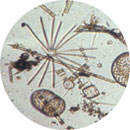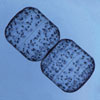- C-MORE Home
- Member Area
- What is Microbial Oceanography?
- What is C-MORE?
- C-MORE Hale
- Research
- Research Cruises
- Data
- Education & Outreach
- People
- Publications
- Microscopy Images
- Professional Development Training Program
- Summer Course
- C-MORE Highlights
- Meeting Facilities
- Contact Us
What is Microbial Oceanography?
Microbial Oceanography is the scientific discipline concerned with the biology and ecology of microorganisms that inhabit the sea.
 Microbes dominate our planet, especially our oceans. The distinguishing feature of microorganisms is their small size, usually defined as less than 100 micrometers
(µm); they are all invisible to the naked eye. The similarity may end there. As a group, sea microbes are extremely diverse taxonomically, and extremely versatile
with respect to their metabolic capabilities. For example, some marine microorganisms use the energy derived from sunlight to fix (reduce) carbon dioxide into organic
matter, while others use organic matter as a carbon and energy source and produce carbon dioxide as a respiration end-product. Still others may use sunlight and
organic matter simultaneously or intermittently as their metabolic strategy of survival. More exotic pathways involving the oxidation and reduction of one or more
of a variety of inorganic substrates can also occur.
Microbes dominate our planet, especially our oceans. The distinguishing feature of microorganisms is their small size, usually defined as less than 100 micrometers
(µm); they are all invisible to the naked eye. The similarity may end there. As a group, sea microbes are extremely diverse taxonomically, and extremely versatile
with respect to their metabolic capabilities. For example, some marine microorganisms use the energy derived from sunlight to fix (reduce) carbon dioxide into organic
matter, while others use organic matter as a carbon and energy source and produce carbon dioxide as a respiration end-product. Still others may use sunlight and
organic matter simultaneously or intermittently as their metabolic strategy of survival. More exotic pathways involving the oxidation and reduction of one or more
of a variety of inorganic substrates can also occur.
 The discipline of microbial oceanography strives to understand, in a comprehensive and holistic sense, the role of microorganisms in the structure and function
of marine ecosystems. Accordingly, microbial oceanographers make field observations of the distributions, abundances, diversity and metabolic activities of
microorganisms in the sea and use this information to develop and test ecological hypotheses about the role that microbes play in global biogeochemical cycles,
energy transduction and related ecosystem processes. This research requires a comprehensive understanding of ocean chemistry and physics as well as its
biology/microbiology.
The discipline of microbial oceanography strives to understand, in a comprehensive and holistic sense, the role of microorganisms in the structure and function
of marine ecosystems. Accordingly, microbial oceanographers make field observations of the distributions, abundances, diversity and metabolic activities of
microorganisms in the sea and use this information to develop and test ecological hypotheses about the role that microbes play in global biogeochemical cycles,
energy transduction and related ecosystem processes. This research requires a comprehensive understanding of ocean chemistry and physics as well as its
biology/microbiology.
Investigations in the Center for Microbial Oceanography will contribute to this general understanding of their role in planetary habitability and will endeavor to link microbial genomes to the biomes that they help to sustain.
How do we study marine microbes?
 A variety of approaches currently exists to study microbes in the sea. One option is to isolate individual cell types (pure cultures) for subsequent, controlled
laboratory-based investigations. This approach has been used to determine detailed structural, genetic or metabolic characteristics of the microorganism in question.
This information is invaluable and cannot easily be obtained by any other means. For many isolated microorganism we now have full genome sequences and for others
we have well-established genetic systems.
A variety of approaches currently exists to study microbes in the sea. One option is to isolate individual cell types (pure cultures) for subsequent, controlled
laboratory-based investigations. This approach has been used to determine detailed structural, genetic or metabolic characteristics of the microorganism in question.
This information is invaluable and cannot easily be obtained by any other means. For many isolated microorganism we now have full genome sequences and for others
we have well-established genetic systems.  These pure culture “model” systems can be used to explore, through direct experimentation, processes such as metabolic
regulation, cell reproduction and other key processes of life. Unfortunately, this pure culture path is not amenable for the meaningful study of ecological
relationships between and among related and unrelated microbes, or for investigations of the interactions between microbes and their chemical/physical environments.
These latter studies require a mixed microbial assemblage approach, usually under in situ or simulated in situ conditions. In these latter studies, the open sea
is the “laboratory setting.”
These pure culture “model” systems can be used to explore, through direct experimentation, processes such as metabolic
regulation, cell reproduction and other key processes of life. Unfortunately, this pure culture path is not amenable for the meaningful study of ecological
relationships between and among related and unrelated microbes, or for investigations of the interactions between microbes and their chemical/physical environments.
These latter studies require a mixed microbial assemblage approach, usually under in situ or simulated in situ conditions. In these latter studies, the open sea
is the “laboratory setting.”
Investigations in the Center for Microbial Oceanography will adopt both the pure culture-laboratory and the ecological-field approaches, and will integrate the data and understanding derived from each measurement strategy into meaningful models that link microbial genotype to ocean phenotype.



